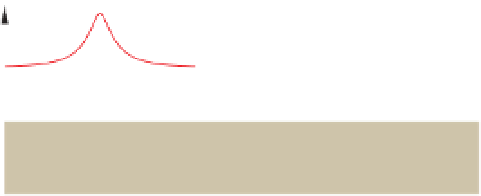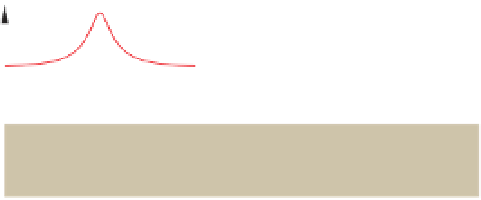Geoscience Reference
In-Depth Information
The amplitude of the anomaly decreases the further the
source is from the transmitter (if there is one). Also,
increasing source
a)
l
+
A
detector separation causes the ampli-
tude of the response to decrease and to extend over a wider
area, i.e. there is an accompanying increase in wavelength
(
-
0
-
) of the anomaly. The increased separation could be
because the source is at a greater depth below the surface
or because the sensor is at a greater height above the
surface, as in the case of airborne measurements. When
the source varies in shape, this variation also affects the
anomaly, with increasing source width producing longer
Figures 2.4
and
2.49a
(see
Section 2.11.4
)
illustrate some
important characteristics of many kinds of geophysical
responses. In general, the deeper the anomalous body
and/or the smaller its property contrast, the larger its size
must be in order for it to be detectable against the inevit-
able background noise (see
Section 2.4
)
. Also, anomalies
with the same amplitude and wavelength can be caused by
various combinations of source depth, geometry and con-
trast with the host rocks. Without additional information
about these variables, the actual nature of the source of the
anomaly is indeterminable. This problem of ambiguity is
discussed further in
Section 2.11.4
.
In summary, whether or not an anomalous physical
property distribution produces a recognisable geophysical
response depends on its size and the magnitude of the
contrast between it and the surrounding rocks. In addition,
the physical property contrast of a geological feature can
change markedly as the properties of the surrounding
rocks and/or those of the target feature change, both lat-
erally and with depth. This can significantly change the
nature of the geophysical response; it can form multiple
geophysical targets related to different parts of the same
geological feature and even change the type of geophysical
measurements needed to detect it.
λ
P
=Positive
P
=Negative
b)
+
0
-
P
=Smaller
P
=Larger
c)
+
0
-
d)
+
0
-
Figure 2.4
The general characteristics of a geophysical response and
how these change with variations in (a) sign of the physical property
contrast (
P), (b) magnitude of the contrast, (c) depth of the source
and (d) shape of the source.
Δ
2.4
Signal and noise
characteristics of (non-seismic) geophysical responses using
a simple shaped anomaly. A negative contrast produces an
anomaly that is an inverted image of that for an identical
positive contrast of the same source geometry (
Fig. 2.4a
). The
amplitude (A) of an anomaly depends on the magnitude of
the physical property contrast and the physical size of the
anomalous distribution. In general, increasing the property
contrast increases the amplitude of the anomaly proportion-
ally.
Figure 2.4b
shows that for two bodies of the same size the
anomaly has larger amplitude when there is a larger contrast.
A measurement of any kind, but especially one made in a
setting as complex and unpredictable as the natural envir-
onment, will be contaminated with unwanted information.
This unwanted information is known as noise and is a
source of error in a measurement, whilst the information
being sought in the measurement is known as signal. The
relative amounts of signal and noise in a measurement are
quanti
ed by the signal-to-noise ratio (SNR). Ideally, one
hopes that the amplitude of the signal, the signal level, is as






























































Search WWH ::

Custom Search